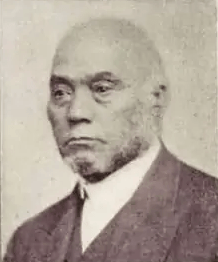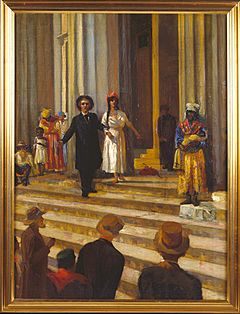John R. Anderson (minister) facts for kids
Quick facts for kids John R. Anderson |
|
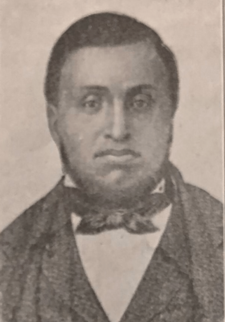 |
|
| Born | 1818 in Shawneetown, Illinois |
|---|---|
| Died | May 20, 1863 (aged 44–45) in St. Louis, Missouri |
| Church | Central Baptist Church |
| Other names | J. Richard Anderson |
| Spouse | Nancy Barton Anderson |
John R. Anderson, also known as J. Richard Anderson (1818–May 20, 1863), was an American minister from St. Louis, Missouri. He worked hard to end slavery and to bring education to African Americans.
When he was a boy, John was an indentured servant. This meant he had to work for someone for a set time to pay off a debt or learn a trade. He gained his freedom at age 12.
Anderson worked for newspapers, including an anti-slavery one. He helped start the Antioch Baptist Church in Brooklyn, Illinois. Later, he returned to St. Louis and helped found the Central Baptist Church. He was its second pastor until he died in 1863.
More than half of his church members were enslaved people. Reverend Anderson helped them become free. He encouraged them to file freedom suits (legal cases to gain freedom). He also raised money to buy their freedom. He was a spiritual guide to Harriet Scott and Dred Scott. Their case, Dred Scott v. Sandford, was a very important one heard by the Supreme Court.
In 1854, Anderson took over the floating Freedom School after its founder, John Berry Meachum, passed away. He also pushed for schools for Black children. He worked with a group of ten people to create both paid (subscription) and public schools in the city. After ten years, a law was passed in 1864 that provided money for public schools. By that year, four subscription schools were also open. In the early 1860s, he started the first African American Masonic temple west of the Mississippi River.
Contents
Early Life and Education
John Richard Anderson was born in 1818 in Shawneetown, Illinois. His parents had been enslaved in Virginia. As a child, Anderson moved with the family he worked for to Missouri. Because he had lived in Illinois territory, he was legally free. However, he was treated like a slave until he was 12. Sarah Bates, the sister of a U.S. Attorney General, freed Anderson and his mother, Chloe Anderson, on January 25, 1830.
As a child, John learned to read at a Sunday school. He got most of his education in reading and religious studies at John Berry Meachum's "Freedom School." This school was held on a riverboat on the Mississippi River. Anderson tried to attend evening schools in St. Louis, but he was told to leave because he was not white. He was later baptized at the First African Baptist Church.
Working with Newspapers
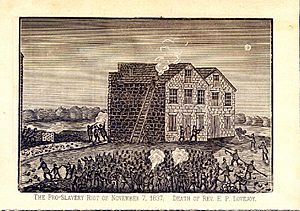
Anderson first worked for the Missouri Republican newspaper. He was so good at distributing papers that he was hired to work inside the office. He became a press roller and then a typesetter. Later, Anderson moved to Alton, Illinois, to work with Elijah Parish Lovejoy. Lovejoy was an activist and editor who was against slavery. Anderson worked as his typesetter for the Alton Observer newspaper. He was there when Lovejoy was killed in Alton in 1837. Anderson saw the murder and the destruction of the printing press.
His Ministry Work
Anderson became a minister at the Union Baptist Church in Alton. In 1838, he started the Antioch Baptist Church in his home in Brooklyn, Illinois. He later returned to St. Louis and started a business with Richard Sneethen.
Anderson was a minister at the First African Baptist Church in St. Louis until 1846. In August 1846, he and 20 other people founded the Central Baptist Church. Reverend Richard Sneethen was the first minister of this church. In 1847, Anderson became an associate pastor with Sneethen. When Sneethen moved to a new church, Anderson became the second pastor in 1849. He served in this role until 1863.
More than half of the church members were enslaved men and women. They needed special passes from their slaveholders to walk the streets and attend church. Anderson could not support his family on his church earnings alone. So, he also worked as an assistant police officer at the City Jail for the rest of his life.
In 1852, the Central Baptist Church building was finished. It cost $12,000. Anderson gave one year's salary to help pay for it and raised the rest of the money. He held a special religious event called a revival every year. By the 1850s, Anderson served over 1,000 church members.
Activism for Change
Anderson was an activist who fought against slavery. He gave loans to help buy the freedom of enslaved people. This stopped them from being sold to work on cotton farms in the Deep South. The Central Baptist Church gained two of its leaders after Anderson bought them from a slave pen in St. Louis. Their names were Merriman Ramsey and Henry Lee. He also helped African Americans file freedom suits in court. Anderson often carried baskets of food and other items to help the poor and hungry.

Harriet Robinson Scott, a member of the Central Baptist Church, asked Anderson for advice about her freedom suit. Anderson was also a spiritual advisor to Harriet and her husband, Dred Scott.
After John Berry Meachum died in 1854, Anderson took over the Freedom School for African American children. He worked with Galusha Anderson, a white Baptist minister, for ten years. Together, they pushed the St. Louis school system to provide education for Black children. Anderson served on a special board of education created to provide schooling for Black students. This was the first and only board of its kind in the city. The ten members included three Black ministers, two Black businessmen, and three white people.
A subscription school opened in 1856, charging one dollar per student. By 1864, four public schools were established. There were also four subscription schools operating in the basements of Black churches. This was a big achievement because many people, even some who opposed slavery, believed African Americans should not be educated. The St. Louis Board of Education asked the government to pass laws to fund schools for African American children. A law was passed in 1866 to provide money for four or five public schools.
Personal Life and Legacy
Anderson met Nancy Barton in Alton. They were married on November 9, 1838, in Madison, Illinois. They had five children: Mandy J., Simon P., May E., Matilda, and Martha Anderson. His son, Simon Peter Anderson, also became a pastor of the Central Baptist Church later on.
John Anderson and Henry Mcghee Alexander became masons during a trip to Boston. In the early 1860s, Anderson helped start the McGhee Lodge (H. McGee Lodge) in St. Louis. This was the first masonic organization for African Americans west of the Mississippi River.
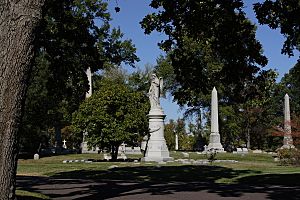
John R. Anderson died on May 20, 1863. He was buried in the Bellefontaine Cemetery next to John Berry Meachum. A historical marker at the cemetery remembers his efforts to provide education for African Americans. It also honors his work as a minister and a community leader.


